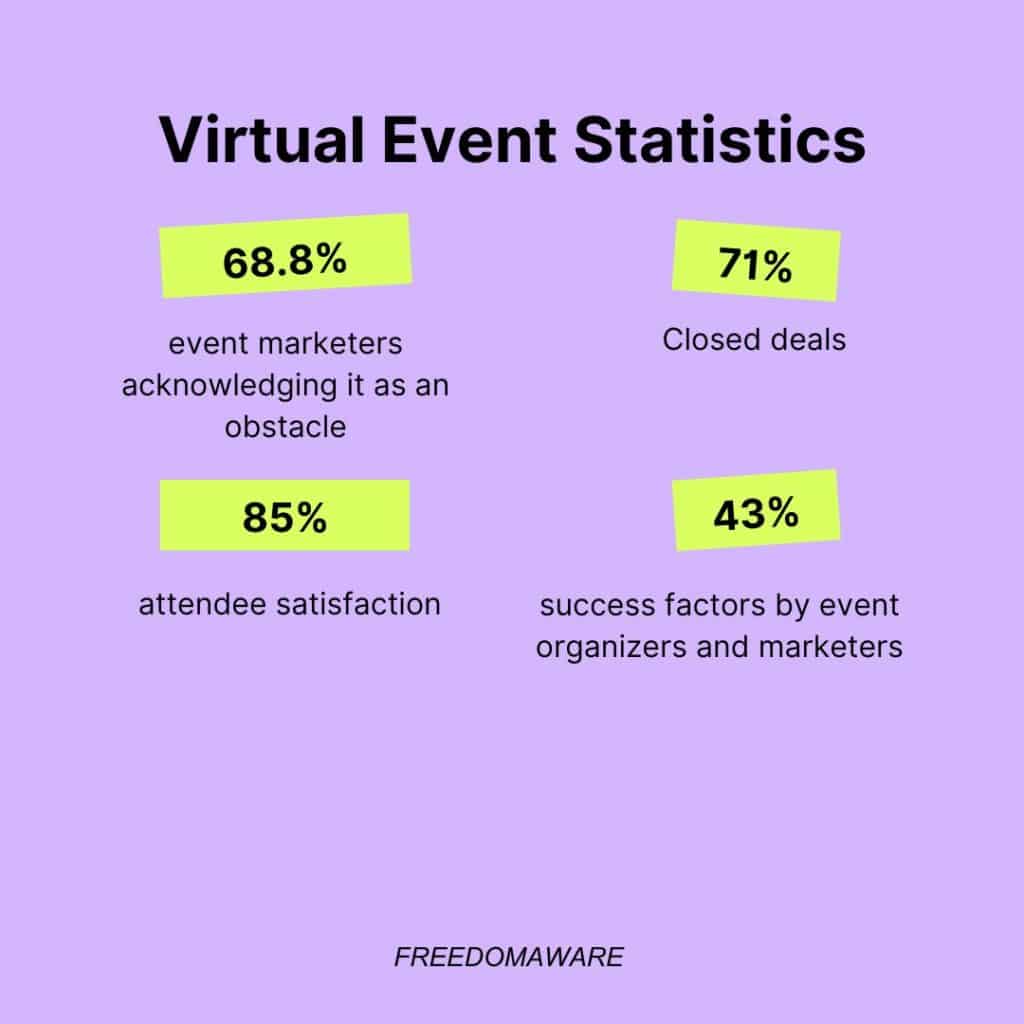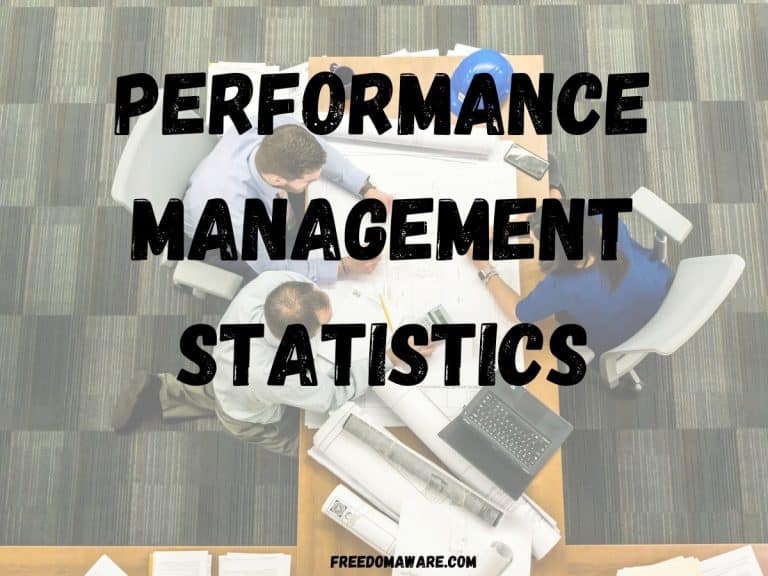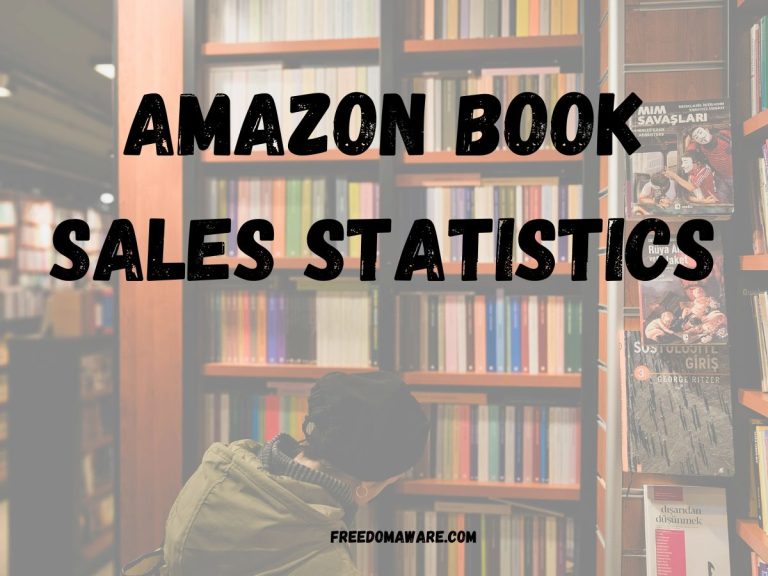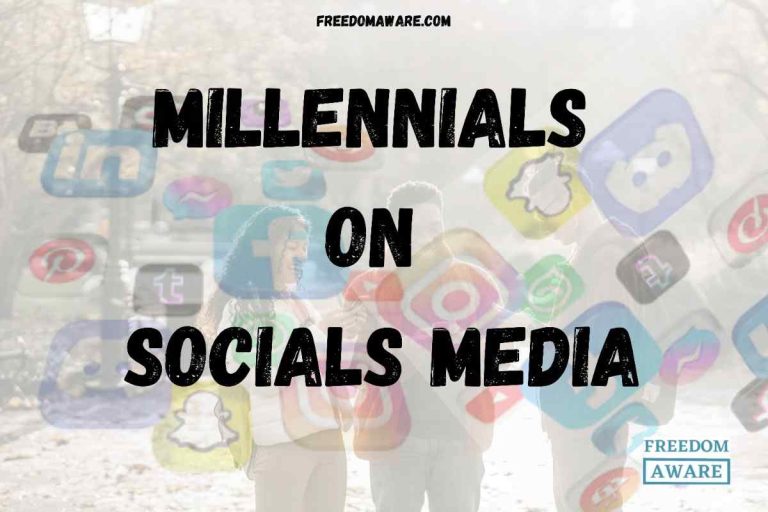81 Top Virtual Event Statistics For Marketers & Organizers (2025)
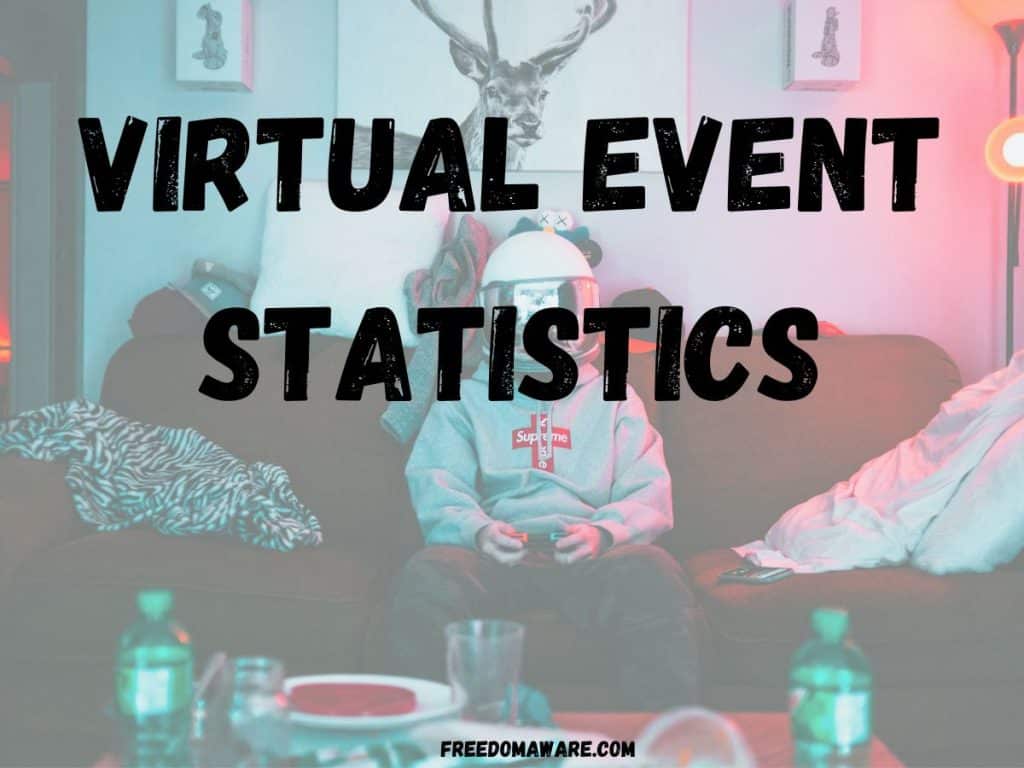
Here are some Virtual event Statistics to help you in 2024 and beyond :
Data is king when it comes to innovative business choices, and the world of virtual events is no exception.
The COVID-19 pandemic fueled a surge in virtual event platforms. In essence, virtual events let people connect and participate online instead of gathering in person.
Feeling overwhelmed by planning a virtual event? Relax, I’ve compiled essential statistics to guide you through planning, promotion, and hosting a smash-hit event.
But before we dive into the numbers, let’s explore the various types of virtual events.
Unveiling the Virtual Event Landscape: A Look at Key Formats
Let’s break down the exciting world of virtual events! Here are some of the most popular formats:
- Webinars: Imagine an online presentation hosted by a company or organization broadcast live to a chosen audience on their computers. That’s the magic of a webinar!
- Virtual Conferences: Think of a traditional conference but without the travel! Virtual conferences allow attendees from anywhere in the world to participate in live sessions and events happening at a real-world location, all from the comfort of their computers.
- Internal Hybrid Events: These events are designed to connect your company’s internal staff, including clients, partners, employees, and leadership. They combine virtual participation with a physical location.
- External Hybrid Events: This format opens the doors to a broader audience beyond your company. Think conferences, summits, concerts, networking events, workshops, classes, trade shows, and product launches – all with both in-person and virtual participation options!
Virtual Events Statistics: A Booming Industry
The virtual event landscape is experiencing explosive growth! Here are some key statistics to chew on:

- Market on the Move (virtual event statistics): The global virtual event market is projected to surge at a staggering 21.4% compound annual growth rate (CAGR) between 2022 and 2030. (Source)
- Marketing Must-Have: In the realm of virtual events statistics, a whopping 74% of businesses consider virtual events a cornerstone of their overall marketing strategy. (Source)
- Revenue Rocket (virtual event statistics): The virtual event market was a powerhouse in 2021, exceeding $116 billion in revenue. By 2030, that number is expected to skyrocket to a mind-blowing $810.2 billion. (Source)
- Virtual Boom: The shift to virtual events is undeniable. In 2021, 92% of organizers embraced virtual experiences, which climbed to a staggering 98% in 2022. Additionally, 67% of companies leveraged hybrid events (combining virtual and in-person elements) to fuel brand growth. (Source)
- Attendee Appetites: Virtual events statistics have shown that while 43% of attendees crave more virtual conferences in 2023, the desire for in-person connection remains strong, with 48% planning on-site events. Interestingly, 41% also show interest in virtual roundtables. (Source)
- Virtual Here to Stay: The virtual event trend is far from fading. A whopping 94% of surveyed companies in 2022 planned to host virtual events, solidifying their place in the event landscape. (Source)
- Learning is King: The primary reason people flock to virtual events? To gain knowledge about companies and their products – making virtual events a powerful educational tool. (Source)
- Webinars Rule Small Business (virtual event statistics): In the realm of virtual events statistics, small businesses are embracing webinars with gusto. A survey revealed that a remarkable 99% of over 2,000 small businesses incorporate webinars into their marketing plans. (Source)
Filling Those Virtual Seats (virtual event statistics): Attendance Trends
Let’s delve into the world of virtual event attendance! Here are some compelling statistics:

- Live Webinars on Fire: In virtual events statistics, The number of people attending live webinars has skyrocketed by 66% in the past two years, highlighting their growing popularity. (Source)
- Last-Minute Mania: Mark your calendars! Virtual events statistics have shown that Over 68% of registrations for virtual or hybrid events happen within a week of the event date. (Source)
- Pandemic Push (virtual event statistics): The pre-pandemic world saw only 45% of people attending virtual events. Thankfully, that number has surged to a whopping 87% due to the lasting effects of COVID-19. (Source)
- In-Person Attendance Blues: In the realm of virtual events statistics for 46% of marketers, securing a solid turnout remains a significant hurdle for in-person events. Virtual events seem to be offering a more reliable solution. (Source)
- Virtual Advantage: Virtual events boast an average attendance of 1,356, exceeding the average of 908 attendees for traditional meetings. It looks like virtual gatherings might attract a wider audience! (Source)
- Measuring Success: Virtual event statistics show that nearly half (45%) of companies rely on total registration and attendance figures to gauge the success of their virtual events. (Source)
- Free Events Dominate: In virtual events statistics, a massive 74% of event marketers choose to offer virtual events for free, making them a cost-effective way for attendees to participate. (Source)
- Small Scale, Small Price Tag (virtual event statistics): Hosting a virtual event with a cozy group of 10-100 attendees? Expect a monthly cost range of $50-$250.(Source)
Large Scale, Larger Costs: Jumbo events with 500-2500+ attendees come with a higher monthly price tag, ranging from $625 to $8,000.
- Cost per Guest: According to virtual event statistics to 33.7% of event marketers, you can expect to spend an average of $500-$1,000 per virtual attendee. (Source)
- Sponsorship Revenue Streams (virtual event statistics): Monetization opportunities exist! The average virtual sponsorship package costs around $8,456, offering a potential revenue stream for organizers. (Source)
- Platform Power: Virtual event statistics show that a whopping 87% of event planners actively seek platforms that allow virtual booth sponsorships, highlighting the value of this revenue source. (Source)
- Hybrid Hurdle: Finding the right price point can be tricky! In the realm of virtual events statistics, Roughly 32% of businesses grapple with pricing as the biggest challenge for hybrid events. (Source)
- Event Size & Spending (virtual event statistics): The cost varies depending on the event size. Small virtual events (under 250 attendees) range from $3,000 to $15,000, while larger events can set you back between $5,000 and $30,000.(Source)
- Accessibility Advantage: Virtual events are budget-friendly for attendees! Only 10% require a paid ticket, compared to over 25% of hybrid or in-person events. (Source)
- Future Investment: The future is virtual! A significant 57.7% of businesses plan to increase their budget for online events, with another 35.4% unsure but open to the possibility. (Source)
- ROI Timeline: In the realm of virtual events statistics, Patience is key! For 74% of B2B virtual event organizers, it takes six months to see a positive return on investment (ROI). (Source)
- COVID-19 Impact (virtual event statistics): Due to COVID-19, in 2020, there was a significant shift towards virtual events. A staggering 74.9% of event planners switched from in-person to virtual, while 47% canceled events and 39.8% postponed them.(Source)
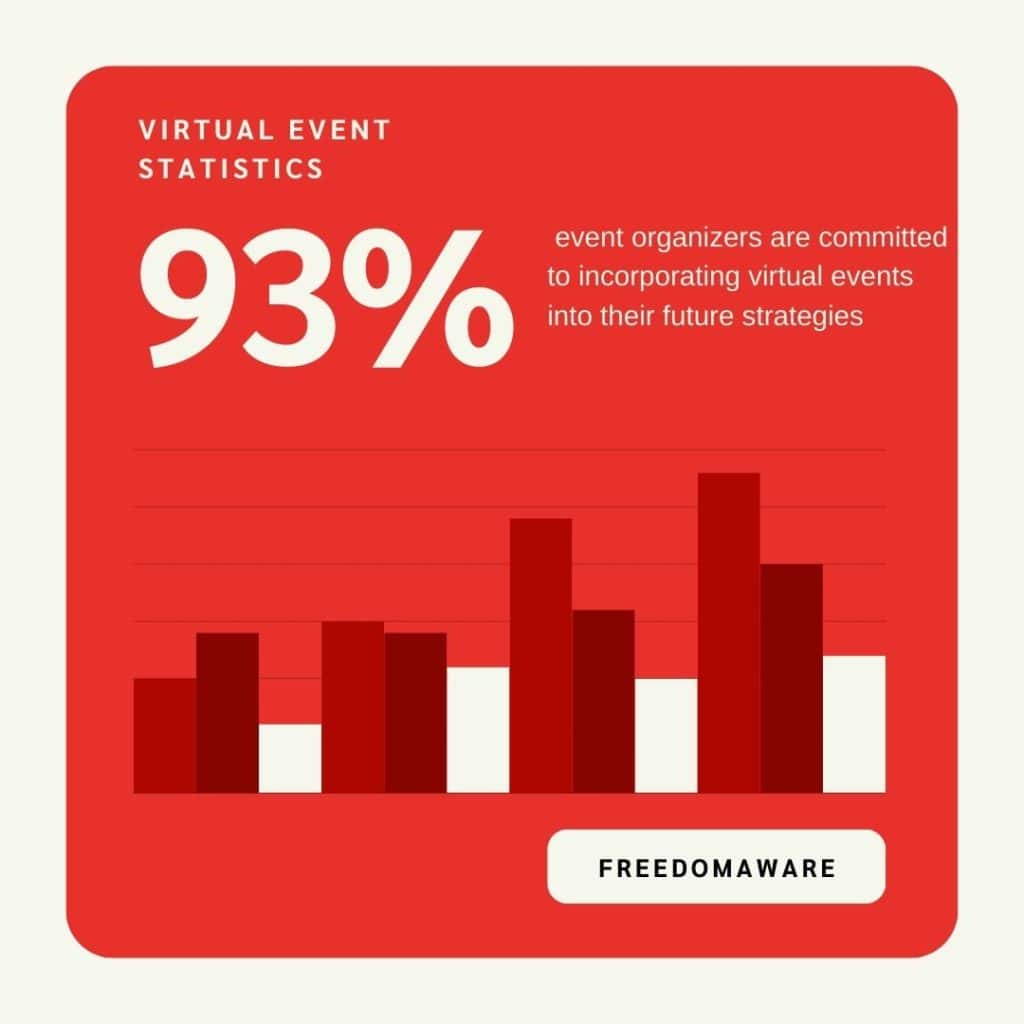
Planning & Promotion (virtual event statistics):
- Promotion Timeline: The average virtual event promotion time is 56 days, so plan ahead!(Source)
- Virtual Here to Stay: A significant 93% of event organizers are committed to incorporating virtual events into their future strategies.(Source)
- Spreading the Word: Email marketing reigns supreme, virtual event statistics shows that with 40% of event marketers considering it the most effective channel for virtual event promotion.(Source)
- Interestingly, 59% of marketers would even cancel an in-person event to prioritize a virtual one.(Source)
- B2B Focus: However, for B2B marketers, their website takes the crown as the most effective marketing channel.(Source)
Virtual Event Design:
- Speaker Spotlight (virtual event statistics): On average, virtual events typically feature around 20 speakers.(Source)
- The Virtual Pivot (virtual event statistics): A massive 93% of surveyed marketers plan to shift from in-person to virtual events in 2023, although only 30% have a concrete plan in place.(Source)
- Focus on Learning (virtual event statistics): The primary reason attendees join virtual events? Education! A whopping 80% participate to gain knowledge.(Source)
- Promotion Timeframe (virtual event statistics): While small virtual events require 3-6 weeks for successful promotion, larger events might need more prep time. A significant 65% of marketers say they need over six weeks for large-scale events.(Source)
The Future of Virtual Events:
- Virtual is Here to Stay: Embracing the shift, 85.3% of event marketers believe virtual experiences are a permanent fixture in the event landscape.(Source)
Measuring Success (virtual event statistics):
- Opportunities Abound: In the realm of virtual events statistics For 87% of marketers, the opportunities generated by virtual events are a key success factor.(Source)
- Top Benefits: Increased registrations, attendee engagement, and higher ROI are the top three benefits of virtual events, according to surveyed organizers.(Source)
Challenges & Considerations (virtual event statistics):
- Networking Hurdle: Creating substantial networking opportunities remains challenging for virtual events; statistics show that 68.8% of event marketers acknowledge it as an obstacle. (Source)
- Success Factors: Closed deals (71%). (Source)
- Virtual events statistics show that attendee satisfaction is (85%). (Source)
- and replicating event formats virtually (43%) are all considered success factors by event organizers and marketers. (Source)
- Finding Speakers: Fortunately, 39.5% of event organizers consider it easy to find great speakers for virtual events. (Source)
- Logistics & Focus: While 52.5% of event marketers find logistics challenging. (Source)
- A positive note is that 91% of surveyed companies report their virtual event was successful. (Source)
- Additionally, 54% of event planners prioritize attendee experience over logistics. (Source)
- Technical Glitches: Technical problems can occur, with 38% of marketers facing them. Investing in good microphones is crucial. (Source)
- 70% of event planners consider them critical to a successful virtual event. (Source)
- The Hybrid Advantage: While virtual is prominent, 67% of businesses find hybrid events more beneficial. (Source)
- Engagement Challenge: Keeping attendees engaged remains a hurdle, with 67.7% of event marketers finding it difficult. (Source)
Virtual Events: Keeping Your Audience Captivated
Here’s how virtual events are winning over audiences and driving engagement:
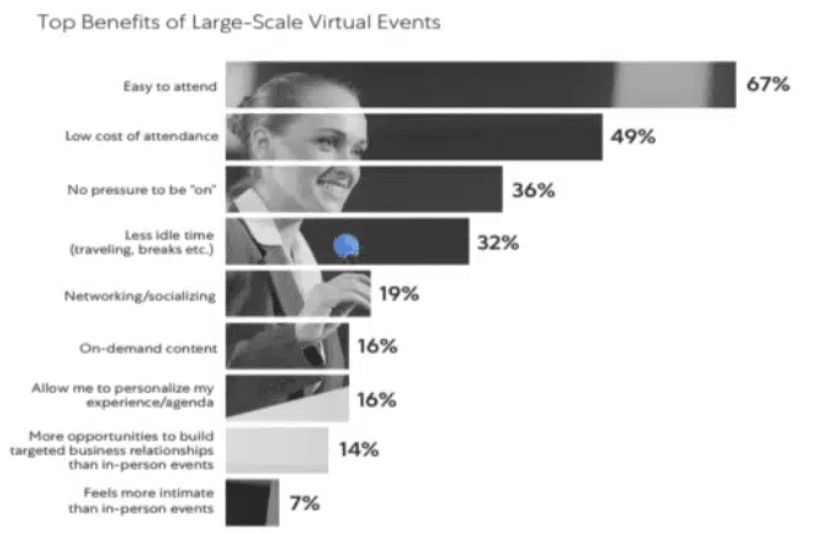
- Target Audience Outreach (virtual event statistics): In the realm of virtual events statistics, 45.3% of surveyed business marketers leverage online events to connect with their target audience. (Source)
- Mobile Engagement Matters (virtual event statistics): Mobile apps are game-changers! 62% of event marketers say they boost audience engagement in virtual events. (Source)
- High Satisfaction Rates (virtual event statistics): The good news? 73% of virtual event attendees walk away satisfied with their experience. (Source)
- Engagement Strategies (virtual event statistics): Polling is a widespread technique, with 71% of marketers using it to keep audiences interactive. (Source)
- Benefits for Attendees (virtual event statistics): What makes virtual events popular? Here’s what attendees say: According to 67%, the top perk is the ease of attendance. (Source)
- For 49%, virtual events offer a low-cost way to participate. (Source)
- Reduced pressure to be physically present benefits 36% of attendees. (Source)
- In-Person Preference (virtual event statistics): In a head-to-head battle, in-person events win for B2B marketers! Over 57% prefer the in-person experience at hybrid events, compared to 33% who favor the virtual option. The remaining 10% are undecided. (Source)
- Webinar Reigns Supreme (virtual event statistics): When it comes to virtual event formats, webinars take the crown! Over half (51%) of surveyed virtual event visitors prefer them, while live meeting software follows closely behind at 43%. (Source)
- Zooming Ahead (virtual event statistics): Zoom is the preferred virtual event platform for companies that host them. A significant 50.3% choose Zoom, followed by Microsoft Teams at 12% and Facebook Live at 9.4%. (Source)
The Challenge of Virtual Fatigue (Virtual Event Statistics): Keeping Audiences Engaged
Virtual events have become a mainstay, but there’s a potential downside: fatigue. Here’s how it can impact attendees and organizers:
- Audience Attention Span: A red flag for B2B marketers! Virtual event statistics show that Half of surveyed B2B tech marketers and influencers report a significant level of virtual event fatigue among customers, with another 40% experiencing some fatigue. (Source)
- Zoom Fatigue is Real: For virtual event attendees, Zoom fatigue is the biggest challenge, impacting 54% of them. This highlights the need for engaging formats. (Source)
- Combating Fatigue: Experts recommend keeping virtual events concise, with an ideal length of 3-5 hours, to minimize fatigue. (Source)
- Organizer Challenges: Virtual fatigue isn’t just an attendee issue. Nearly 38% of surveyed companies identify it as a significant challenge when running virtual events, likely due to participants experiencing it from attending too many similar events. (Source)
The Rise of Hybrid Events: Blending the Best of Both Worlds (virtual event statistics)
Hybrid events are emerging as a popular choice, combining the virtual and in-person experiences. Let’s delve into the trends and challenges surrounding them:
- Hybrid’s Growing Popularity: While virtual events remain prominent, hybrid events are gaining traction. Among marketers planning virtual events in 2023, 18% will incorporate a hybrid format. (Source)
- High Demand: The future looks bright for hybrid events! An overwhelming 97% of respondents anticipate seeing more of them. (Source)
- In fact, over 90% of companies believe large-scale events will be virtual or hybrid in 2023.(Source)
- B2B Preference: However, B2B marketers seem to favor the in-person aspect of hybrid events. Over half (57%) prefer the in-person experience. (Source)
- Challenges to Overcome: Creating a seamless experience across virtual and in-person elements presents the biggest hurdle for hybrid events. Nearly half (49%) of B2B marketers cite this as their primary obstacle. (Source)
- Managing hybrid logistics (42%) and convincing attendees to attend in person (36%) are also significant challenges. (Source)
- Driving Innovation & Connection: C-suite executives see the value of hybrid experiences. 43% of critical countries invest in hybrid events to offer more innovative and personalized experiences, while 40% emphasize fostering a stronger connection with their audience. (Source)
- The Virtual Shift: The pandemic accelerated the virtual trend. According to a 2021 survey of over 8,000 marketers, 40% of events were predicted to be virtual in 2022, with in-person and hybrid events each capturing 35%. (Source)
- The Long-Form Boom: Get ready for long videos! Webinars, live events, and similar long-form video content have witnessed a staggering surge of over 11,000% growth in the past decade, making them the fastest-growing video segment. (source)
- Emphasizing the Trend: B2B marketers are placing a growing emphasis on content marketing, with 71% indicating its increased importance to their organizations in the last year. (source)
- Emphasizing the Widespread Use: In 2021, the power of visuals became undeniable. More than half of marketers used them in 91% of their content pieces. (source)
- Highlighting Originality: When it comes to visuals, marketers are getting creative! A Venngage survey reveals that original graphics reign supreme, used by 36% of marketers, followed closely by stock photos at nearly 34%. (source)
- Highlighting Blog Focus: Blogs are a top destination for visual content! A study reveals that 30% of marketers prioritize creating visuals specifically for blogs, followed by social media platforms like Facebook and LinkedIn. (source)
- Focusing on the WHO Statistic: The World Health Organization estimates that 2.2 billion people globally have visual impairments. (source)
- Focusing on Widespread Use: Visual content reigns supreme in marketing strategies. A survey reveals that over 50% of marketers consider it essential. (source)
- Focusing on the Pain Point: Visual content creation can be challenging! According to a survey, 33% of marketers find consistently producing visual content their biggest content production challenge. (source)
- Highlighting Mobile Dominance: Short-form video content captivates the US! An impressive 75% of adults in the US use mobile devices to watch this type of content. (source)
- Focusing on Viewing Behavior: Gen Z viewers are hooked on short-form videos for discovery! A significant 59% leverage these apps to find content, leading them to watch more extended versions elsewhere. (source)
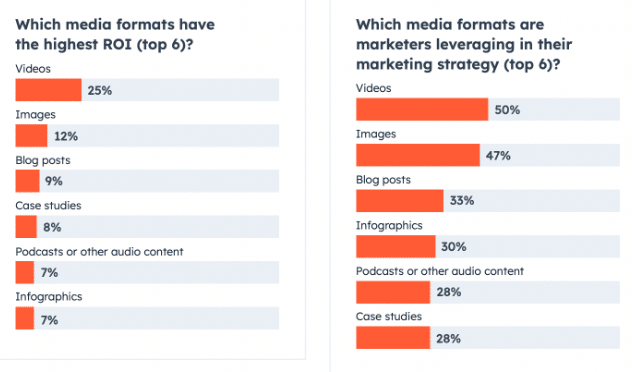
The Virtual Revolution: Key Takeaways and Moving Forward (virtual event statistics)
The data speaks for itself – virtual events are a powerful force in today’s marketing landscape. Here are some key takeaways to inform your 2024 marketing strategy:
- Virtual Events Here to Stay: These statistics paint a clear picture: virtual events are not a passing fad. They offer a valuable and accessible way to connect with your audience.
- Embrace the Power of Virtual: Consider incorporating virtual events into your 2024 marketing plan. The potential for engagement, education, and brand awareness is undeniable.
- Learn & Grow: People attend virtual events to learn about your company and offerings. Use these insights to craft compelling content that resonates with your target audience.
- Data-Driven Decisions: Let the statistics be your guide! This information provides valuable insights to help you develop a solid virtual event plan for 2024.
- Beyond Numbers: While statistics offer a strong foundation, remember that the human element is crucial. Focus on creating engaging and interactive experiences for your virtual attendees.
By leveraging these key takeaways and staying informed about virtual event trends, you can position your brand for success in the ever-evolving marketing landscape.

